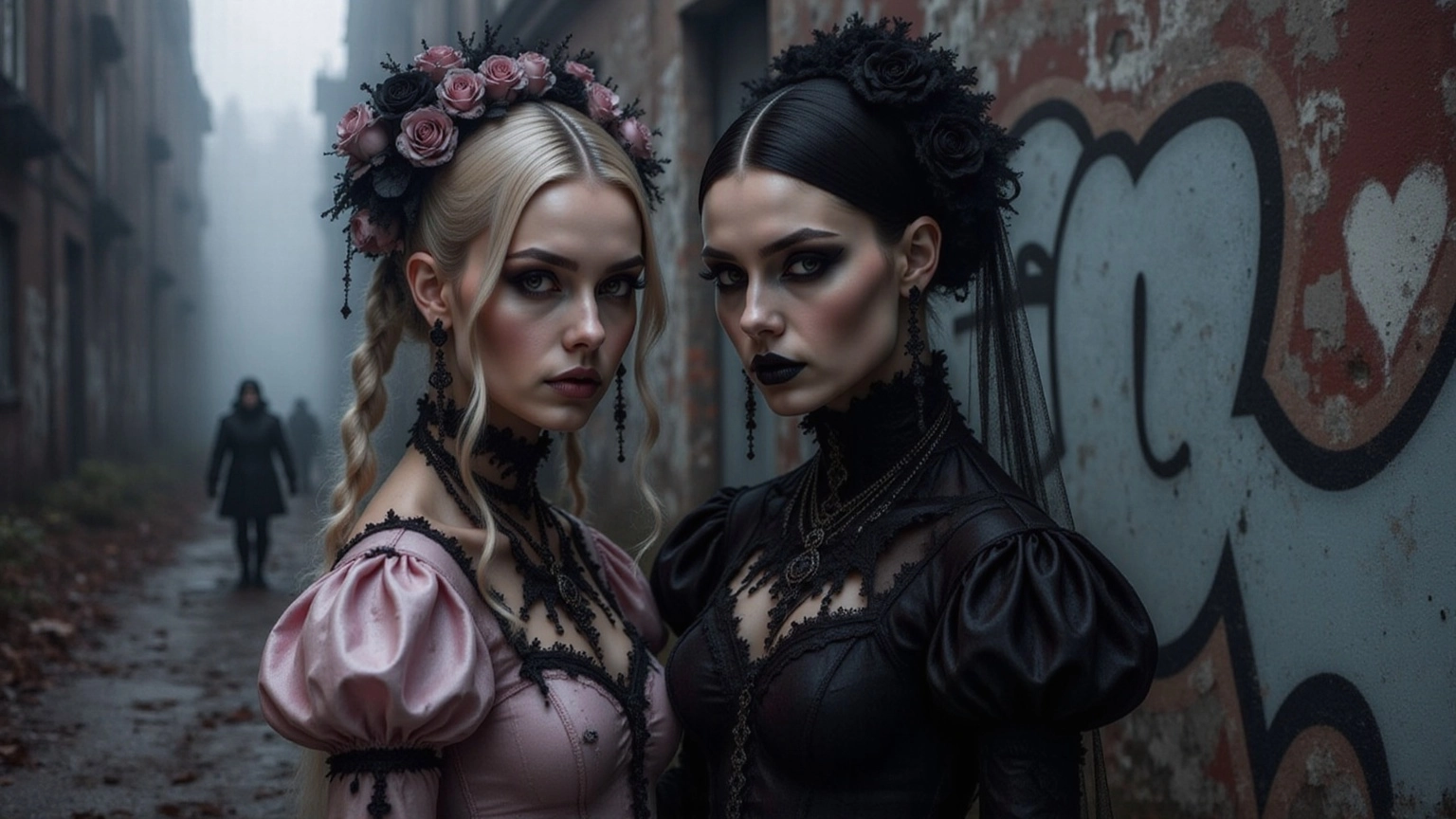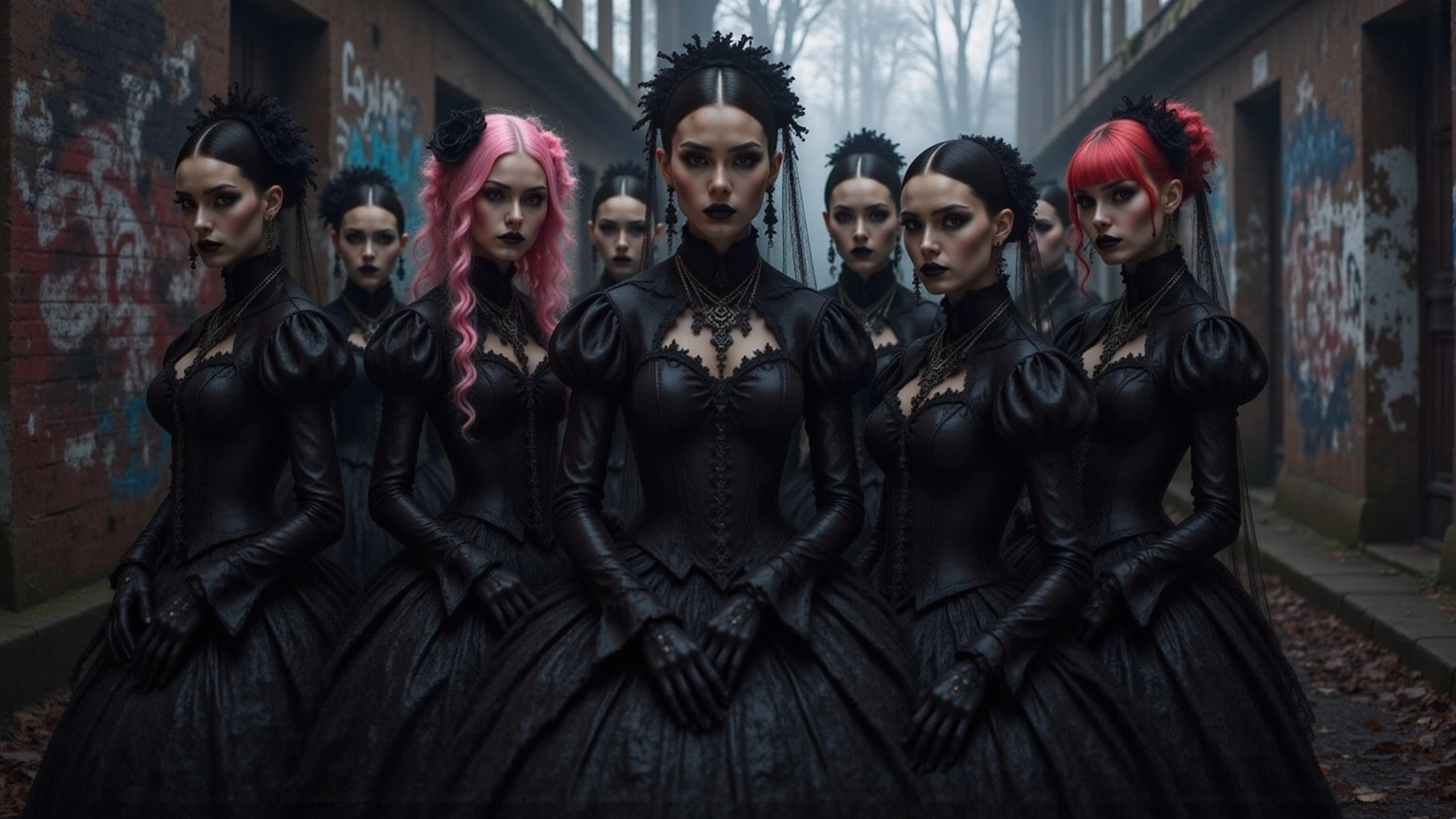
Understanding the Emo and Goth Difference: Culture and Style Insights
Share
Overview
What separates emo from goth? Dive into the shadows where these subcultures pulse with life, each echoing with its own haunting melody. Emo, with its raw vulnerability, invites you into a world of introspection—feel the weight of every lyric, the ache of every heartbeat. In contrast, goth drags you deeper into existential realms, where darkness is not just an aesthetic but a way of being. Here, beauty intertwines with the macabre, offering a seductive dance of self-expression and community.
Both paths are unique, yet they converge in their quest for authenticity. They challenge you to confront your emotions, to embrace the shadows and find solace in the company of kindred spirits. So, which journey will you embark upon? Explore the depths, let the music guide you, and uncover the secrets that lie within these vibrant subcultures.
Introduction
The distinction between emo and goth subcultures unveils a captivating tapestry of emotional expression and cultural identity, both born from the punk rock movement yet diverging in striking ways. Emo, with its heartfelt lyrics and introspective themes, carves out a sanctuary for vulnerability and personal storytelling. In contrast, goth revels in the darker facets of existence, finding beauty in the macabre.
As these subcultures evolve, reshaping contemporary fashion and music, a compelling question emerges:
- How do these contrasting identities mold the experiences of their communities?
- What can they teach us about the intricate dance of emotional engagement in today’s world?
Dive deeper; the shadows may hold the answers.
Define Emo and Goth: Origins and Cultural Significance
The emo and goth difference showcases two distinct subcultures, both originating from the punk rock scene, yet each possesses its own unique identity and cultural significance. Emo, short for 'emotional hardcore,' surged forth in the mid-1980s from the heart of Washington D.C. It’s a realm marked by introspective lyrics and a raw emphasis on expressive themes, often delving into personal experiences like heartbreak and angst. The music of Emo resonates deeply, echoing themes of vulnerability and self-reflection, creating a sanctuary where individuals can confront their feelings and share their struggles. As Paramore hauntingly articulates, "What a shame, what a shame we all remain such fragile broken things," capturing the emotional honesty that defines this genre.
In stark contrast, the Gothic genre emerged in the late 1970s in the UK, evolving from the post-punk music scene. This group is drawn to the macabre, exploring themes of death, beauty, and existentialism. The Gothic aesthetic? Think dark attire, striking makeup, and an obsession with the eerie and mysterious. While both subcultures share a punk rock lineage, the emo and goth difference is significant in their cultural expressions and aesthetic values. Research reveals a stark reality: young people identifying as Goths are more likely to grapple with depression and self-harm, with studies indicating that 37% of adolescents self-identifying as Goths reported self-harm, compared to just 10% of their non-Goth peers.
Understanding Emo’s origins and its variations is crucial for grasping the emo and goth difference. The emo and goth difference is highlighted by emo's dedication to genuine honesty and personal storytelling, contrasting sharply with goth's exploration of darker themes and the beauty that lurks within them. Both movements have carved a lasting impact on music and youth culture, offering distinct pathways for self-expression and community. As My Chemical Romance reminds us, 'We'll carry on, we'll carry on,' a rallying cry that underscores the resilience both groups inspire in their communities.

Explore Emo and Goth Styles: Fashion, Music, and Aesthetics
Emo fashion? It’s all about snug jeans, band t-shirts, and those iconic studded belts and wristbands. Picture vivid hair colors, styled with dramatic flair—each hue reflecting the music's intensity. This community emerged in the mid-1980s, peaking from the late '80s to the late 2000s, with legends like My Chemical Romance and Dashboard Confessional leading the charge. Their heartfelt lyrics and melodic sounds resonated with a generation hungry for personal expression. Since 2004, hip hop artists sampling emo tracks have reignited interest, showcasing the genre's evolution. The emo aesthetic? A powerful canvas for self-expression, where individuals reveal their identities through unique styles, echoing early emocore roots like those of Rites of Spring.
Now, let’s shift to goth fashion. It embraces dark, dramatic clothing steeped in Victorian and medieval influences. Think corsets, lace, and heavy makeup, all draped in a color palette dominated by black and deep jewel tones. The goth music scene, born in the early '80s, birthed genres like gothic rock and darkwave, with iconic bands such as Bauhaus and Siouxsie and the Banshees shaping its haunting sound. The goth aesthetic isn’t just a fascination with the macabre; it’s a portal to explore existentialism and romance, inviting individuals to engage with life’s darker aspects.
Are you curious about the emo and goth difference between both subcultures? They celebrate individuality and community, empowering members to narrate personal stories through fashion and music, highlighting the emo and goth difference. As these styles evolve, they continue to influence contemporary culture. The resurgence of emo and goth aesthetics in 2025 melds nostalgia with modern interpretation. This ongoing evolution underscores the cultural impact of both movements, inviting new generations to delve into their identities through the rich tapestry of emo and goth styles. It’s much like the unique lifestyle experience offered by Darc Arts, intertwining gothic elegance with the therapeutic allure of THCA.
Contrast Emo and Goth: Emotional Expression and Identity
Emo culture resonates with raw sensitivity and personal struggles, compelling individuals to bare their souls. The music? A cathartic release, echoing the heart's deepest aches. Emo souls connect with themes of heartbreak, loss, and introspection, weaving a community that cherishes authenticity and profound bonds. Research reveals that Emo enthusiasts express their feelings more freely and enjoy greater social support than their non-Emo counterparts, potentially mitigating mental health risks.
In stark contrast, Gothic culture delves into the shadows, exploring death and the supernatural through a philosophical lens. While both tribes embrace emotions, Goths often dance with their feelings, cloaked in irony, viewing life through an existential prism. Research indicates that teens entwined in the alternative scene are 1.6 to 3.7 times more likely to meet the criteria for depression compared to outsiders. This suggests that the existential themes that permeate this culture can lead to a deeper engagement with life, offering a unique perspective that, while enriching, may also expose vulnerabilities.
Tom ter Bogt notes that a fondness for Gothic music can signal emerging depressive states, hinting at the intricate psychological dynamics within this community. Thus, while both subcultures carve rich pathways for psychological exploration, the emo and goth difference in their approaches to emotional engagement and identity yields varied psychological landscapes. What lies beneath the surface of these cultures? Dive deeper, and you might just uncover the secrets they hold.
Examine the Evolution of Emo and Goth: Modern Interpretations and Influences
Emo and alternative subcultures? They've undergone radical transformations, echoing the ever-shifting societal attitudes and artistic expressions. And guess what? Emo is back, and it’s not just a whisper—it’s a roar. This resurgence fuses genres like rap and alternative rock, igniting a new wave of Emo-inspired music and fashion that captivates a younger crowd hungry for emotional authenticity. Artists like Halsey, Machine Gun Kelly, and Willow Smith are not just redefining Emo and pop punk; they’re reshaping the very landscape of the genre. TikTok? It’s the pulse of this revival, breathing new life into early 2000s tracks and drawing fresh fans into the fold.
On the flip side, gothic culture is also evolving, embracing modern interpretations that meld minimalism with contemporary fashion. Streetwear and DIY culture now dance together, reflecting a deeper engagement with personal expression. Social media? It’s the lifeblood of this transformation, fostering communities and amplifying visibility for both subcultures. As the emo and goth difference continues to weave its influence through popular culture, both styles stand as essential expressions of individuality and depth. They beckon new generations to delve into their rich histories and embrace their unique identities.
At Darc Arts, we revel in this intersection of gothic elegance and emotional wellness. We invite cannabis enthusiasts to explore the profound connections between these cultures and our unique offerings—like our premium THCA prerolls infused with diamonds, promising a hauntingly powerful cannabis experience. Ready to dive deeper?

Conclusion
Exploring the emo and goth difference reveals two vibrant subcultures that, while rooted in punk rock, diverge dramatically in emotional expression, aesthetics, and cultural weight. Emo culture champions vulnerability and personal storytelling, crafting a haven for individuals to confront their feelings and forge connections through shared experiences. In stark contrast, goth culture plunges into darker themes, inviting a philosophical engagement with life’s complexities and the haunting beauty of the macabre.
Key insights pulse through the narrative, showcasing emo fashion’s expressive flair—think snug jeans and electric hair colors—while goth fashion revels in dramatic, dark aesthetics steeped in historical influences. The music of both subcultures is pivotal in shaping their identities, with emo spinning heartfelt narratives and goth delving into existential depths. The relentless evolution of these movements mirrors contemporary societal shifts, as emo and goth continue to ignite inspiration in new generations through modern interpretations and influences, like social media and genre fusion.
Ultimately, grasping the emo and goth difference unveils a rich tapestry of emotional expression and identity. As these subcultures morph, they carve out unique paths for self-discovery and community connection. Embracing the complexities of these identities fosters a deeper appreciation for the myriad ways individuals navigate their emotions and experiences. Engaging with emo and goth cultures sparks a broader dialogue about mental health, creativity, and the transformative power of personal expression in an ever-shifting world.
Frequently Asked Questions
What are the origins of emo and goth subcultures?
Emo originated in the mid-1980s from the punk rock scene in Washington D.C., while goth emerged in the late 1970s in the UK, evolving from the post-punk music scene.
How does emo music differ from goth music?
Emo music is characterized by introspective lyrics and themes of vulnerability, personal experiences, and emotional honesty. In contrast, goth music explores darker themes such as death, beauty, and existentialism.
What themes are commonly associated with emo culture?
Emo culture often delves into personal experiences like heartbreak and angst, emphasizing emotional expression and self-reflection.
What are the typical aesthetic elements of goth culture?
The gothic aesthetic includes dark attire, striking makeup, and an obsession with the eerie and mysterious.
How do the emotional experiences of individuals identifying as goths compare to those who do not?
Research indicates that young people identifying as goths are more likely to experience depression and self-harm, with 37% of adolescents self-identifying as goths reporting self-harm compared to just 10% of their non-goth peers.
What is the cultural significance of both emo and goth subcultures?
Both emo and goth subcultures have a lasting impact on music and youth culture, offering distinct pathways for self-expression and community, with emo focusing on personal storytelling and goth exploring darker themes.
